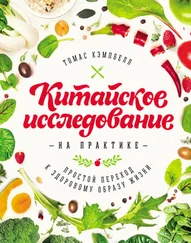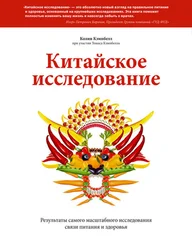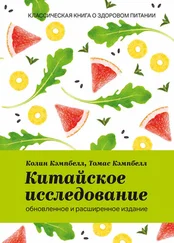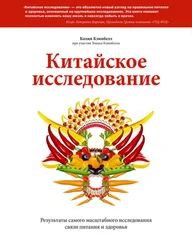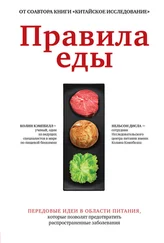Rothwell N. J., and Stock M. J. “Influence of carbohydrate and fat intake on diet-induced thermogenesis and brown fat activity in rats fed low protein diets.” J. Nutr. 117 (1987): 1721–1726.
Krieger E., Youngman L. D., and Campbell T. C. “The modulation of aflatoxin (AFB1) induced preneoplastic lesions by dietary protein and voluntary exercise in Fischer 344 rats.” FASEB J. 2 (1988): 3304 Abs.
Chen J., Campbell T. C., Li J., et al. Diet, Life-style and Mortality in China. A Study of the Characteristics of 65 Chinese Counties. Oxford, UK; Ithaca, NY; Beijing, PRC: Oxford University Press; Cornell University Press; People’s Medical Publishing House, 1990.
Chen J., Campbell T. C., Li J., et al. Diet, Life-style and Mortality in China. A Study of the Characteristics of 65 Chinese Counties. Oxford, UK; Ithaca, NY; Beijing, PRC: Oxford University Press; Cornell University Press; People’s Medical Publishing House, 1990.
Chen J., Campbell T. C., Li J., et al. Diet, Life-style and Mortality in China. A Study of the Characteristics of 65 Chinese Counties. Oxford, UK; Ithaca, NY; Beijing, PRC: Oxford University Press; Cornell University Press; People’s Medical Publishing House, 1990.
Уровень смертности составлял 82, но примерно треть случаев одного и того же заболевания повторялась у людей другого возраста.
Это также означает, что очень мало или совсем нет полезных данных при включении показателей всех людей в округе. Есть только один показатель заболевания для каждого округа; при этом необходимо иметь только один показатель для любой из переменных для сопоставления с индикатором заболеваемости.
Piazza A. Food Consumption and Nutritional Status in the People’s Republic of China. London: Westview Press, 1986.
Messina M., and Messina V. The Dietitian’s Guide to Vegetarian Diets. Issues and Applications. Gaithersburg, MD: Aspen Publishers, Inc., 1996.
Chen J., Campbell T. C., Li J., et al. Diet, Life-style and Mortality in China. A Study of the Characteristics of 65 Chinese Counties. Oxford, UK; Ithaca, NY; Beijing, PRC: Oxford University Press; Cornell University Press; People’s Medical Publishing House, 1990.
Holick M. F. В: M. E. Shils, J. A. Olson, M. Shike, and A. C. Ross (eds.). Modern Nutrition in Health and Disease, 9-е издание, 329–345. Baltimore: Williams and Wilkins, 1999.
Barger-Lux M. J., Heaney R., Dowell S., et al. “Vitamin D and its major metabolites: serum levels after graded oral dosing in healthy men.” Osteoporosis Int. 8 (1998): 222–230.
Биологический период полувыведения витамина D составляет 10–19 дней, то есть за это время он теряет половину своей силы.
Colston K. W., Berger U., and Coombes R. C. “Possible role for vitamin D in controlling breast cancer cell proliferation.” Lancet 1 (1989): 188–191.
Nieves J., Cosman F., Herbert J., et al. “High prevalence of vitamin D deficiency and reduced bone mass in multiple sclerosis.” Neurology 44 (1994): 1687–1692.
Al-Qadreh A., Voskaki I., Kassiou C., et al. “Treatment of osteopenia in children with insulin-dependent diabetes mellitus: the effect of 1-alpha hydroxyvitamin D3.” Eur. J. Pediatr. 155 (1996): 15–17.
Cantorna M. T., Hayes C. E., and DeLuca H.F. “1,25-Dihydroxyvitamin D3 reversibly blocks the progression of relapsing encephalomyelitis, a model of multiple sclerosis.” Proc. National Acad. Sci. 93 (1996): 7861–7864.
Rozen F., Yang X.-F., Huynh H., et al. “Antiproliferative action of vitamin D-related compounds and insulin-like growth factor-binding protein 5 accumulation.” J. Nat. Cancer Inst. 89 (1997): 652–656.
Cosman F., Nieves J., Komar L., et al. “Fracture history and bone loss in patients with MS.” Neurology 51 (1998): 1161–1165.
Giovannucci E., Rimm E., Wolk A., et al. “Calcium and fructose intake in relation to risk of prostate cancer.” Cancer Res. 58 (1998): 442–447.
Peehl D. M., Krishnan A. V., and Feldman D. “Pathways mediating the growth-inhibitory action of vitamin D in prostate cancer.” J. Nutr. 133 (Suppl) (2003): 2461S–2469S.
Zella J. B., McCary L. C., and DeLuca H. F. “Oral administration of 1,25-dihydroxyvitamin D3 completely protects NOD mice from insulin-dependent diabetes mellitus.” Arch. Biochem Biophys. 417 (2003): 77–80.
Davenport C. B. “Multiple sclerosis from the standpoint of geographic distribution and race.” Arch. Neurol. Psychiatry 8 (1922): 51–58.
Alter M., Yamoor M., and Harshe M. “Multiple sclerosis and nutrition.” Arch. Neurol. 31 (1974): 267–272.
Van der Mei I. A, Ponsonby A. L., Blizzard L., et al. “Regional variation in multiple sclerosis prevalence in Australia and its association with ambivalent ultraviolet radiation.” Neuroepidemiology 20 (2001): 168–174.
McLeod J. G., Hammond S. R., and Hallpike J. F. “Epidemiology of multiple sclerosis in Australia. With NSW and SA survey results.” Med. J. Austr. 160 (1994): 117–122.
Holick M. F. “Vitamin D: a millennium perspective.” J. Cell. Biochem. 88 (2003): 296–307.
Holick M. F. “Vitamin D: a millennium perspective.” J. Cell. Biochem. 88 (2003): 296–307.
MacLaughlin J. A., Gange W., Taylor D., et al. “Cultured psoriatic fibroblasts from involved and uninvolved sites have a partial, but not absolute resistance to the proliferation-inhibtion activity of 1,25-dihydroxyvitamin Ds.” Proc. National Acad. Sci. 52 (1985): 5409–5412.
Goldberg P., Fleming M. C., and Picard E. H. “Multiple sclerosis: decreased relapse rate through dietary supplementation with calcium, magnesium and vitamin D.” Med. Hypoth. 21 (1986): 193–200.
Andjelkovic Z., Vojinovic J., Pejnovic N., et al. “Disease modifying and immunomodulatory effects of high dose 1a(OH)D3 in rheumatoid arthritis patients.” Clin. Exp. Rheumatol. 17 (1999): 453–456.
Hypponen E., Laara E., Reunanen A., et al. “Intake of vitamin D and risk of Type 1 diabetes: a birth-cohort study.” Lancet 358 (2001): 1500–1503.
Breslau N.A., Brinkley L., Hill K. D., et al. “Relationship of animal protein-rich diet to kidney stone formation and calcium metabolism.” J. Clin. Endocrinol. Metab. 66 (1988): 140–146.
Langman C. B. “Calcitriol metabolism during chronic metabolic acidosis.” Semin. Nephrol. 9 (1989): 65–71.
Читать дальше
![Колин Кэмпбелл Китайское исследование: обновленное и расширенное издание. Классическая книга о здоровом питании [litres] обложка книги](/books/388520/kolin-kempbell-kitajskoe-issledovanie-obnovlennoe-cover.webp)

